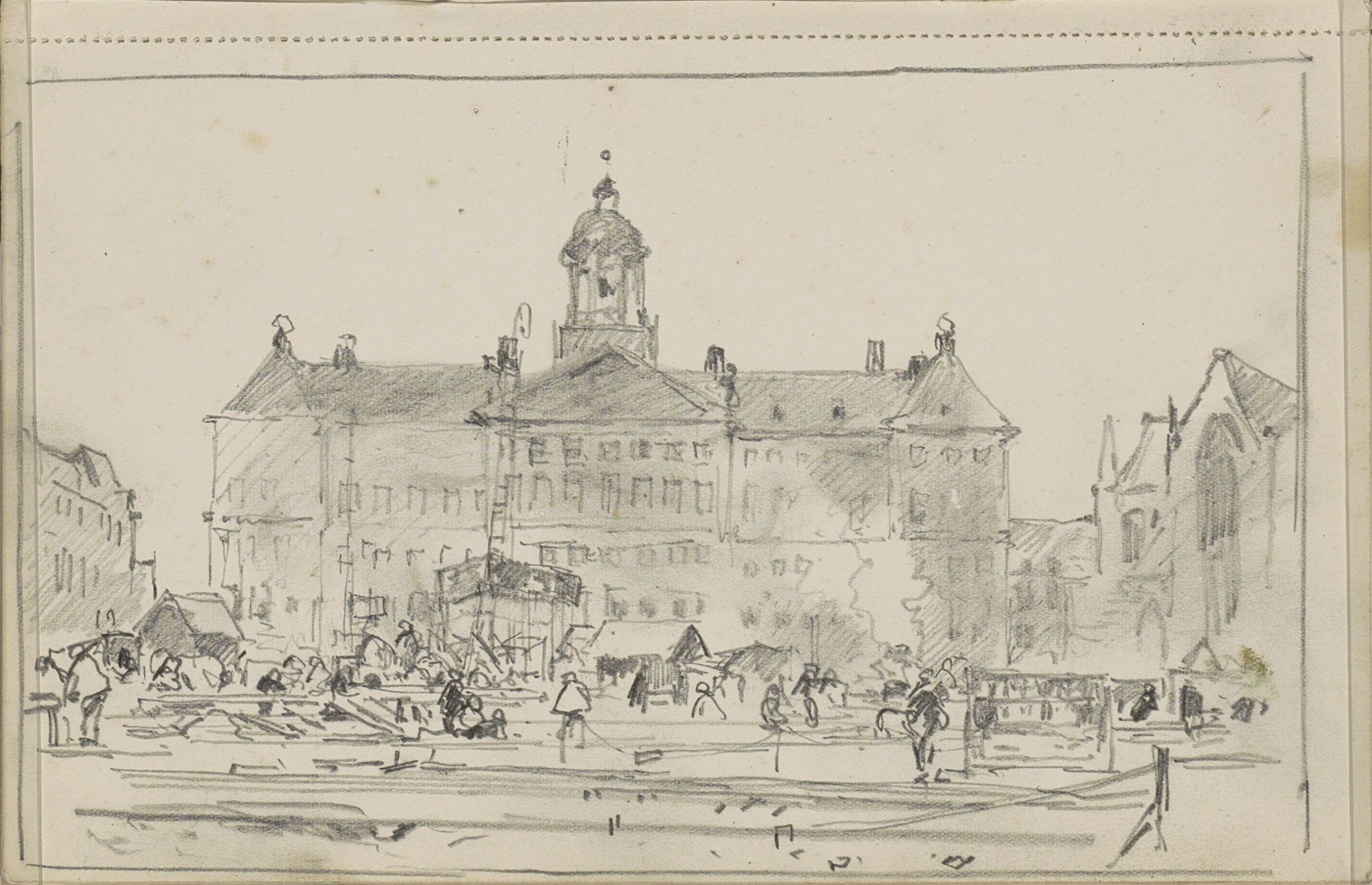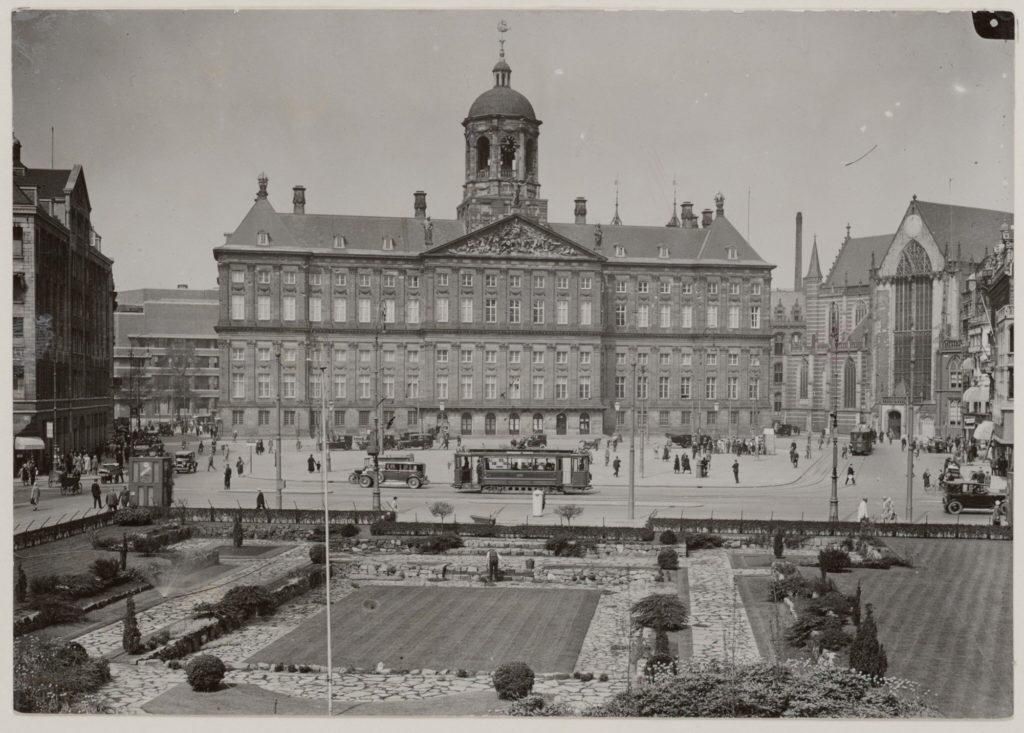
Het Koninklijk Paleis en de Nieuwe Kerk op de Dam, Amsterdam
by Cornelis Vreedenburgh (1880 - 1946)
1927
Olieverf op Doek
Het hoofdmotief van dit monumentale stadsgezicht is het Koninklijk Paleis op de Dam dat, ontworpen door Jacob van Campen, oorspronkelijk gebouwd werd, van 1648 tot 1665, als het nieuwe stadhuis. Nog tijdens de bouw verwierf het faam als het zogeheten Achtste Wereldwonder. Het was destijds namelijk het grootste publiek toegankelijke gebouw van heel Europa. Het was uiteraard onmiddellijk een zeer geliefd onderwerp voor kunstenaars.
Specialisten in het stadsgezicht zoals Jan van der Heyden and Gerrit Berckheyde speelden handig in op de onstilbare honger naar gezichten op het prachtige plein met het imponerende classicistische stadhuis dat toen werd gezien als een symbool van de grote welvaart van de nog jonge Republiek en haar status als maritieme wereldmacht.
Ook in latere tijd bleef het karakteristieke plein met het stadhuis en, zoals hier ook te zien, de gotische Nieuwe Kerk een populair onderwerp. Toen Vreedenburgh deze plek in 1927 in verf vereeuwigde, continueerde hij dus een gevestigde traditie.
Het afgebeelde ‘Damplantsoen’ is een tuin in zogenaamde “Oud-Hollandse” stijl: passend / aansluitend bij het gebouw, voorheen het stadhuis van Amsterdam, gebouwd/ontworpen door Jacob van Campen vanaf 1648 en gereed in 1665.
Het Damplantsoen, was eigenlijk een ruimte die vrijgekomen was door de afbraak (1912) van het voormalige Commandantshuis ( D’Ailly’s Historische Gids van Amsterdam. Bewerking H. F. Wijnman. 1968) en de sloop van de westzijde van de Warmoesstraat. Er was een plan om hier een hotel te bouwen, maar dat is niet doorgegaan. Het Damplantsoen was bedoeld als tijdelijke tussen-oplossing, uniek weergegeven in dit meester schilderij.
We zien op het schilderij op de voorgrond een verdiepte tuin, opgebouwd uit grasvlakken en rechtlijnige bloemenborders. De tuin is verdiept en ontworpen langs een as van symmetrie, die aansluit op de middenas van het paleis.
De tuin wordt ontsloten door een trappartijtje, gelegen in het midden van de dwarsas (voor de tram) en ook zijn dergelijke trapjes te vinden in het midden van de lengte-assen rond het middenperk.
De stijl van ontwerpen doet erg denken aan de stijl van Leonard Springer. Hij is in 1925 (toen de werkzaamheden begonnen) 70 jaar, en alhoewel is gebleken dat hij nog lang niet aan stoppen dacht in dat jaar, is de opdracht hem toch niet gegund.
Extra informatie:
Gesigneerd en gedateerd linksonder: C. Vreedenburgh 1927
Afmetingen: 61 x 91 cm, incl. originele lijst: 87 x 116 cm
SOLD/UNAVAILABLE


The Royal Palace and the Nieuwe Kerk on Dam Square, Amsterdam
by Cornelis Vreedenburgh (1880 - 1946)
1927
Oil on canvas
The main motif of this monumental cityscape is the Royal Palace on Dam Square, which, designed by Jacob van Campen, was originally built from 1648 to 1665 as the new town hall. During construction it gained fame as the so-called Eighth Wonder of the World. At the time it was the largest publicly accessible building in all of Europe. It was, of course, immediately a very popular subject for artists.
Specialists in cityscapes, such as Jan van der Heyden and Gerrit Berckheyde cleverly responded to the insatiable hunger for faces on the beautiful square with the imposing classicist town hall that was then seen as a symbol of the great prosperity of the still young Republic and its status as maritime world power.
The characteristic square with the town hall and, as can be seen here, the gothic Nieuwe Kerk church, also remained a popular subject in later times. When Vreedenburgh immortalized this place in paint in 1927, he continued an established tradition.
The depicted 'Damplantsoen' is a garden in the so-called 'Old Dutch' style: fitting/adjacent to the building, formerly the city hall of Amsterdam, built/designed by Jacob van Campen from 1648 and completed in 1665.
The Damplantsoen was actually a space that had become vacant due to the demolition (1912) of the former Commandantshuis (D'Ailly's Historical Guide to Amsterdam. Edited by H. F. Wijnman. 1968) and the demolition of the west side of Warmoesstraat. There was a plan to build a hotel here, but it eventually got cancelled. The Damplantsoen was intended as a temporary interim solution, uniquely displayed in this master painting.
In the painting the foreground depicts a sunken garden, made up of grass surfaces and rectilinear flowerbeds. The garden is deepened and designed along an axis of symmetry, which connects to the central axis of the palace.
The garden is accessed by a staircase, located in the middle of the transverse axis (in front of the tram) and similar stairs can also be found in the middle of the longitudinal axes around the central arena.
The style of design is very reminiscent of Leonard Springer's style. In 1925 (when the work started) he was 70 years old and, even though he announced that he was still not retiring that year, the contract was not awarded to him.
Additional information:
Signed and dated lower left: C. Vreedenburgh 1927
Size: 61 x 91 cm, Including original frame: 87 x 116 cm
SOLD
SPECIFICATIONS





© TERTIUS GALLERY B.V. - MASTER PAINTINGS (All Rights Reserved)
